Advice for the Home Gardener from the Help Desk of the
UC Master Gardener Program of Contra Costa County
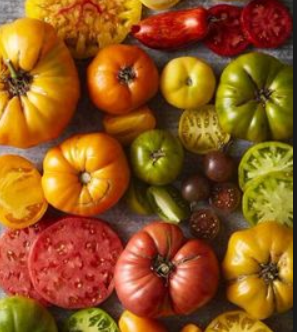
MGCC Help Desk's Response: Thank you for contacting the UC Master Gardener Program Help Desk with your questions. I know the list of available tomato seeds and seedlings can be overwhelming.
Unfortunately, given our area each area can have lots of micro-climates. So we cannot tell you exactly which variety will grow best in your yard. That is highly dependent on your individual circumstances (are you planting in pots, raised beds, the amount of sun, temperature, disease). Your best information on how individual varieties will perform is likely from your successful tomato-growing neighbors.
There is some good information about heirloom tomatoes though. The scientific definition of an heirloom tomato is an open-pollinated variety that will make fruit identical to the parent. This means if you save seeds from your tomatoes you would expect to be able to produce the same fruit year after year. There is disagreement on how old a variety has to be to be considered an heirloom with some saying at least 50 years and others saying at least 100 years. Here are some links to articles written by nearby Master Gardener organizations which discuss heirloom tomatoes in further detail. In addition, if you want to save seed yourself you might look over the website for Seed Savers Exchange.
http://sacmg.ucanr.edu/What_are_Heirloom_Tomatoes/
http://sonomamg.ucanr.edu/The_Kitchen_Garden/All_About_Tomatoes/Heirloom_Tomatoes/
https://www.seedsavers.org/
If you look through our list of tomatoes for our Great Tomato Plant Sale this year, you can see there are lots of different heirloom tomato varieties. It does appear that only one is a determinate variety (Black Sea Man, a slicer). As you likely know, determinate tomato varieties grow in more of a bush form than a vine and tend to set fruit all at once and then decline. For older varieties, most are likely going to be indeterminate. If you look through the offerings on Seed Savers, only 9 out of their 82 heirloom varieties appear to be determinate. You likely have found these lists already but below are the links to our descriptions of all our varieties and the shopping list to make it easier to find what you want the day of the sale.
http://ccmg.ucanr.edu/files/298659.pdf
http://ccmg.ucanr.edu/files/298656.pdf
Thank you for contacting us with your questions. We are very excited to see you for our MGCC tomato sale either on March 30th in Walnut Creek, April 6th in Richmond, or April 13th in Antioch.
Help Desk of the UC Master Gardener Program of Contra Costa County (SES)
Note: UC Master Gardeners Program of Contra Costa's Help Desk is available almost year-round to answer your gardening questions. Except for a few holidays (e.g., last 2 weeks December), we're open every week, Monday through Thursday for walk-ins from 9:00 am to Noon at 2380 Bisso Lane, Concord, CA 94520. We can also be reached via telephone: (925) 608-6683, email: ccmg@ucanr.edu, or on the web at http://ccmg.ucanr.edu/Ask_Us/. MGCC Blogs can be found at http://ccmg.ucanr.edu/HortCoCo/ You can also subscribe to the Blog.
Advice for the Home Gardener from the Help Desk of the
UC Master Gardener Program of Contra Costa County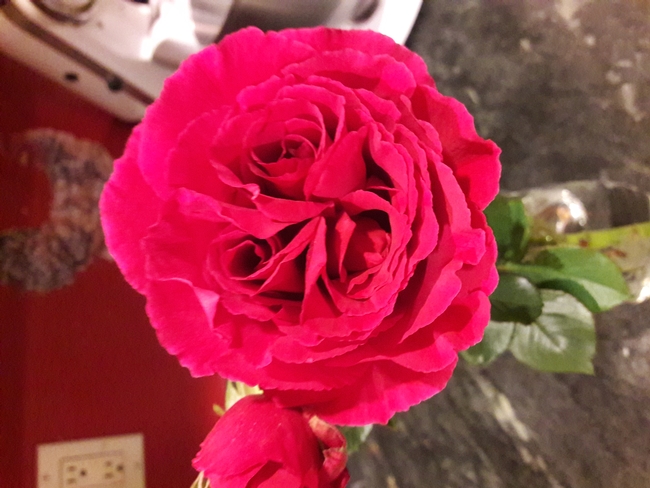
MGCC Help Desk Response: Thank you for contacting the UC Master Gardener Program Help Desk with your question about the change in the appearance of your rose blossoms.
The most common reason for a change in the appearance of rose blossoms is root stock take over, and we suspect this may be the case with your rose. It is not unusual for the rootstock rose to send up suckers and even take over the preferred rose.
Many roses are grafted. This means that a bud from a preferred species is grafted to the rootstock of a different species usually known for its vigor and longevity. Any shoots that grow from stems above the graft union will produce flowers from the preferred species. But any shoot that grows from stems or below the graft union will produce flowers from the rootstock. The two will usually differ in flowers and foliage form and color. You can trace the canes from the rootstock to their point of origination and remove them; otherwise, they will eventually replace the preferred species.
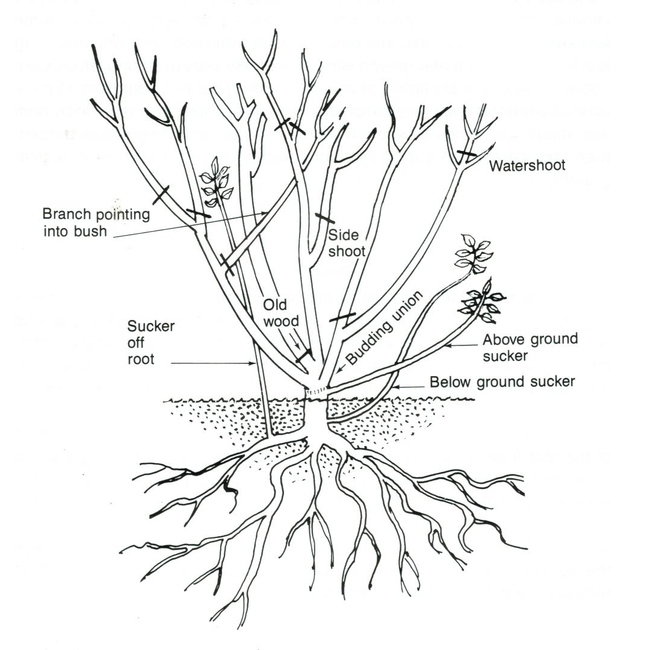
Here are some helpful links to UC information on rose care:
http://ipm.ucanr.edu/PMG/PESTNOTES/pn7465.html
http://ipm.ucanr.edu/PMG/GARDEN/PLANTS/rose.html
http://ipm.ucanr.edu/PMG/PESTNOTES/pn7463.html
If rootstock takeover doesn't appear to be the cause of the change in your rose blossoms, please give us a call and let us know and we can discuss further.
Help Desk of the UC Master Gardener Program of Contra Costa County (SLH)
Note: UC Master Gardeners Program of Contra Costa's Help Desk is available almost year-round to answer your gardening questions. Except for a few holidays (e.g., last 2 weeks December), we're open every week, Monday through Thursday for walk-ins from 9:00 am to Noon at 2380 Bisso Lane, Concord, CA 94520. We can also be reached via telephone: (925) 608-6683, email: ccmg@ucanr.edu, or on the web at http://ccmg.ucanr.edu/Ask_Us/. MGCC Blogs can be found at http://ccmg.ucanr.edu/HortCoCo/ You can also subscribe to the Blog.
Advice for the Home Gardener from the Help Desk of the
UC Master Gardener Program of Contra Costa County
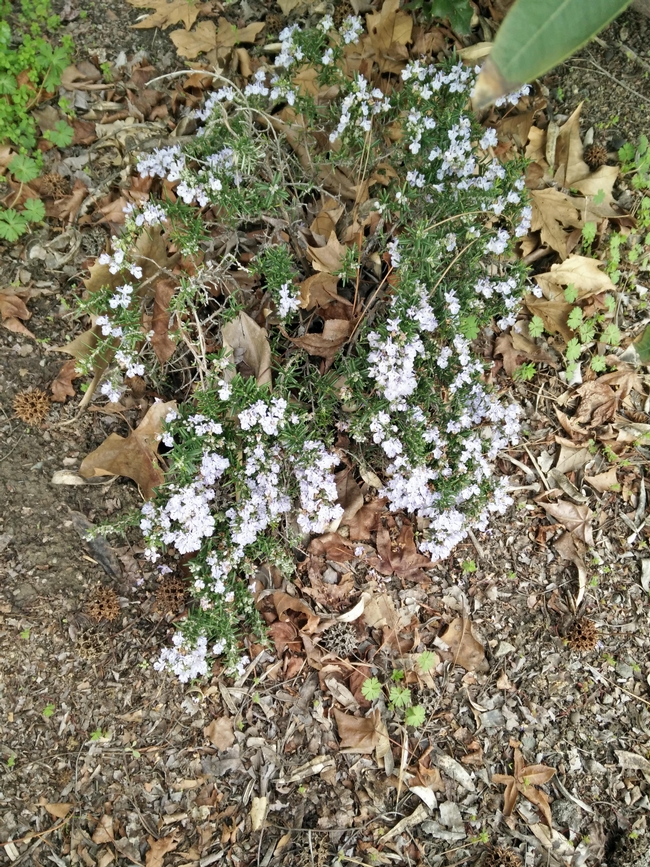
Help Desk Response: Thank you for contacting the UC Master Gardener Program Help Desk.
You sent a photo of a plant for us to identify. It is rosemary (Rosmarinus officinalis). While it's not native to California (it originated in the Mediterranean area), it is very well adapted to California's similar Mediterranean climate. Its flowers range in color from various shades of blue to even pink and white. Its growth habit ranges from stiff and erect, rounded, or low and creeping, depending on variety or cultivar.
This plant is also the rosemary used for seasoning food, however some varieties taste better than others. Bees are attracted to the flowers and make excellent honey when feeding on them.
Good drainage and full sun are essential for a healthy rosemary plant. The links following will take you to more information about growing rosemary: http://ipm.ucanr.edu/PMG/GARDEN/PLANTS/rosemary.html and http://sonomamg.ucanr.edu/Plant_of_the_Month/Rosemary/.
Happy gardening!
Help Desk of the UC Master Gardener Program of Contra Costa County (SEH)
Note: UC Master Gardeners Program of Contra Costa's Help Desk is available almost year-round to answer your gardening questions. Except for a few holidays (e.g., last 2 weeks December), we're open every week, Monday through Thursday for walk-ins from 9:00 am to Noon at 2380 Bisso Lane, Concord, CA 94520. We can also be reached via telephone: (925) 608-6683, email: ccmg@ucanr.edu, or on the web at http://ccmg.ucanr.edu/Ask_Us/. MGCC Blogs can be found at http://ccmg.ucanr.edu/HortCoCo/ You can also subscribe to the Blog.
Advice for the Home Gardener from the Help Desk of the
UC Master Gardener of Contra Costa County

Help Desk Response: Thank you for contacting the UC Master Gardener Program Help Desk with your question about compost.
You said that your compost bin is not getting hot. If the compost pile is not heating up, then the pile is too wet or too dry or there is not enough green material (or nitrogen) present. If too wet, the material should be spread out to dry. If too dry, add moisture to make it “spongy”. If neither of these, then the nitrogen is low and this can be corrected by adding materials high in nitrogen (lawn cuttings, etc.).
You asked whether you can place materials which are not fully composted into the garden bed. My comment was that yes this is possible, but that it will draw nitrogen from the soil to continue the composting process in the garden bed. Also, heat is the driving force to kill funguses or other living material in the pile prior to placing it in the vegetable bed.
We discussed making sure there is enough nitrogen present in the composting contents. The document linked below on rapid composting discusses this –
https://vric.ucdavis.edu/pdf/compost_rapidcompost.pdf
And here is a link on composting basics that you might also find informative:
http://sonomamg.ucanr.edu/composting/composting_basics/
Free Recycle Smart Compost Class: You might also be interested in the compost class offered by Recycle Smart. The class is free, and was developed to help residents understand the importance of organics recycling, build composting systems, recycle food and yard waste at their homes, build healthy urban soils and support thriving landscapes. For APPLICATION, dates and more information visit www.RecycleSmart.org/CompostSmart. The application deadline for the next class is February 22, 2019.
Good luck on your compost. Please do not hesitate to contact the Help Desk if you have more questions.
Help Desk of the UC Master Gardener Program of Contra Costa County (MCW)
Note: UC Master Gardeners Program of Contra Costa's Help Desk is available almost year-round to answer your gardening questions. Except for a few holidays (e.g., last 2 weeks December), we're open every week, Monday through Thursday for walk-ins from 9:00 am to Noon at 2380 Bisso Lane, Concord, CA 94520. We can also be reached via telephone: (925) 608-6683, email: ccmg@ucanr.edu, or on the web at http://ccmg.ucanr.edu/Ask_Us/. MGCC Blogs can be found at http://ccmg.ucanr.edu/HortCoCo/ You can also subscribe to the Blog.
Advice for the Home Gardener from the Help Desk of the
UC Master Gardener Program of Contra Costa County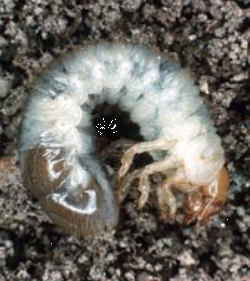
MGCC's Help Desk Response: Thank you for contacting the UC Master Gardener Program's Help Desk about the grubs in your planters. Grubs are primarily pests of lawn grass, preferring turf grass roots to other plants. While they will feed on other plants' roots, they typically are not a big problem in planters.
It's not unusual to find grubs in your soil in the winter. The larvae overwinter in the soil, and emerge in late spring and summer. Your picking them out of the soil and leaving them on top for the birds was exactly the right thing to do. You don't need to discard the soil. Most gardens can tolerate some grubs in the soil, unless the population becomes very high.
For more information about grubs in a vegetable garden MGCC Help Desk covered previously, follow this link: https://ucanr.edu/blogs/blogcore/postdetail.cfm?postnum=25191. Included in that link is another link to using beneficial nematodes to control grubs if you find you continue to have problems.
Happy gardening! Please contact us again if you have more questions.
Help Desk of the UC Master Gardener Program of Contra Costa County (SEH)
Note: UC Master Gardeners Program of Contra Costa's Help Desk is available almost year-round to answer your gardening questions. Except for a few holidays (e.g., last 2 weeks December), we're open every week, Monday through Thursday for walk-ins from 9:00 am to Noon at 2380 Bisso Lane, Concord, CA 94520. We can also be reached via telephone: (925) 608-6683, email: ccmg@ucanr.edu, or on the web at http://ccmg.ucanr.edu/Ask_Us/. MGCC Blogs can be found at http://ccmg.ucanr.edu/HortCoCo/ You can also subscribe to the Blog.

